7 Ways to Make a Buyer-Centric Website
One of the harsh realities about running a business is this: nobody cares about your products or services except you (sorry/not sorry.)
What they do care about is finding solutions to their own problems, and making sure that your website provides them with the information and tools to help them diagnose their problem, determine a solution, and take steps to solve it is a crucial part of turning them from a visitor into a customer or client.
One way that businesses approach helping their audience solve their problems is to link to landing pages based on the problems their product or service can solve. Each of these paths, starting with the landing pages, contains unique content designed to communicate your expertise in solving these problems.
By creating engaging, unique and helpful content, you can build some empathy and move your audience along the buying cycle, prompting them to fill in a contact form, call a number, or send you a request for assistance.
Below are a seven ways to make a buyer-centric website:

1. Make sure your site is current.
Making sure that the content found on the pages of your site is current and up-to-date within your area of expertise, and don't forget to update your employee roster, product lists, and anything other which might change over time. Additionally, having a website with an easy to navigate, up-to-date layout which is optimized for mobile is another integral part of their user experience, and one which will stick with them long after they've navigated away from your page.
2. Have some personality.
your website needs to be a reflection of you and your brand, which means that it needs to convey more about you than just what you offer; everything from the layout, to the tone of your copy, to the photos you choose, must contribute to an overall understanding of who you are.3. Use photos and images.
The days of walls of text are long gone, and people's attention spans are honestly just too short to sift through a page that looks like something written by Charles Dickens.
Luckily digital mediums allow you to break up you text and present it in various ways that don't contribute to your reader going cross-eyed, or worse leaving your page altogether. Some ways you can spruce up your content are:
- Custom photos & memes
- Audio feeds
- Video clips
- Cartoons
- Infographics & charts
4. Make your content interactive.
Getting people involved with your content is one of the easiest ways to keep them interested and move them through your sales cycle. Include charts and forms where applicable, and links to contact you whenever necessary5. Focus on feedback loops.
Don't make visitors hunt around your site for ways to get in touch with you. Easy to find "contact us" links are essential, and direct feedback options like "rate this" buttons, online forums, review and opportunities to post comments allow your visitors to feel more engaged with you beyond just using your services6. Include social media share buttons.
Including social media "share" buttons is a quick and effective way to encourage visitors to your site to engage with and share what you have to say. All your content (blog posts, whitepapers, videos, etc)7. Think about your visitors' learning style.
Some people prefer to read articles, some like videos, and others prefer audio. Some prefer all three! Doing a bit of research and seeing what similar sites are doing to present their information will give you valuable insight into how your visitors will want to consume the information that you have to share.
By focusing on these key elements, you can make sure that your website is buyer-friendly, leads them down the right paths, and (most importantly) is an enjoyable experience for them to use. Remember: for many people, your website is the first glimpse that they get of you as a brand, and their experience will likely dictate their relationship with you from that point onward!
Did I miss anything, or do you have something to add to this post? If so, leave a comment,shoot me an email, or tweet at me on Twitter!
5 Essential Content Marketing Habits
Content marketing is one of the move valuable tools at your disposal to add value to your marketing strategy. Good content educates your audience, prospects potential clients, and when done correctly does a powerful job of advertising your brand message.
However, if you're managing multiple accounts at once and want to stay as organized and focused as possible, it's necessary to start developing the right habits as early as possible. Below are a few key things that I've learned which have helped me save my sanity, and be better at what I do.

1. Track Your To-Dos
I've mentioned my daily checklist in a previous post, but having a concrete, written plan for what you need to do each day/week/month/etc is unbelievably helpful. This is especially true when you're working on a project which requires a team effort, and a bit of project management.
My favourite tool for this purpose is Trello because it's super-easy to learn to use, has a simple design based on columns and checklists, and allows you to drag specific tasks "bubbles" around between columns, so everyone can see where you are on a specific project.
Here's an example via a quick Google Image search to give you an idea of what it looks like:
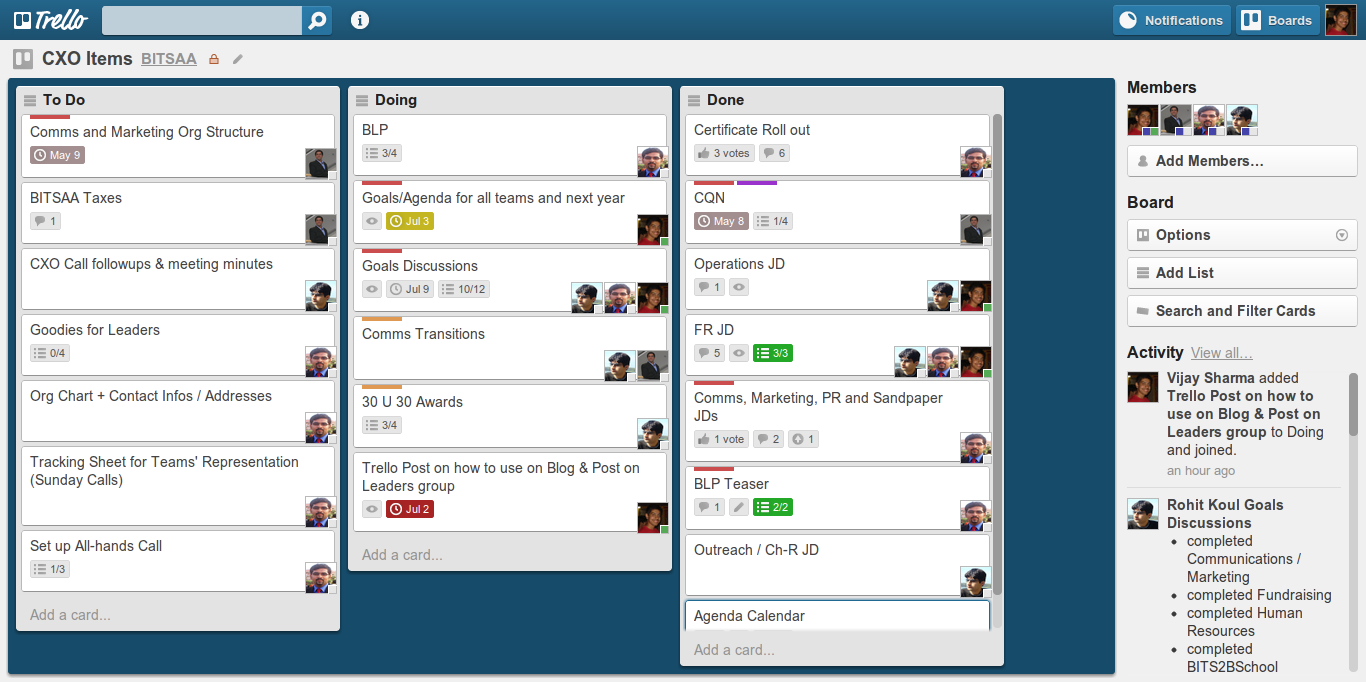
Having tools like Trello (or Asana, or Slack, whatever your preference) helps with communication in teams who may not be in the same office, or even the same country, and allows you to easily keep track of who is working on which portion of the project, and where they're at. Being able to access this stuff at-a-glance is super easy, and saves a ton of time.
2. Establish Milestone and Conversion Goals
Before you sit down and start tweeting or posting, establish what your definition of "successful" looks like. Is it 2,000 newsletter subscribers by Thanksgiving? To speak at a nationwide conference next year? Maybe hit a million visitors to your website this month?
Whatever the case, by developing a clear vision of success and what it looks like not only helps you plan how you will achieve those goals, but also helps you have a clear game plan which can be adapted to deal with any unexpected changes.
Conversions are the best way to measure the success of your campaign (think bread-crumb trail) and anything that you do which leads a user down your breadcrumb trail is worth tracking.
3. Analyze Behaviours and Achievements
Behaviours are the actions that visitors take once they arrive at your website, and achievements are when they behave based on the breadcrumbs that you left for them to follow.
By keeping track of how people move through your (or a client's) website, you can gain valuable information as to how people are getting there, and how they're moving around. Ideally, they'll follow a set of pre-defined steps that you've put in place in order to get them to visit a particular page, or buy a product.
So whenever you identify a new measurable behaviour (maybe your traffic goes up, your website's ranking increases, your click-through rate increases, etc) you can analyze the behaviours that led to the increase, and refine and revise when necessary to make sure things keep going well.
4. Get In the Cloud
This took me longer to get into the habit of doing than I'd like to admit, but saving all your documents, contracts, photos, and work in the cloud (I use Google Drive) is the only way to be truly effective wherever you are, and saves a ton of headache down the road.
Here's an example: I invoiced a client before I went out of town, but they sent me an email a few days later and said that they needed me to re-submit it. So instead of having to worry about re-creating an invoice from scratch because my original document was on my iMac back in Winnipeg, I opened the Google Drive app on my phone, found the invoice (I also have all of my invoice templates saved there, just in case) and re-shared it within the span of a few minutes.
It saved me a ton of time time and and I was able to avoid the headache and stress of re-creating an invoice to make sure I got paid when I was expecting to.
There is literally no excuse for you to not be using a cloud-based sharing service, so get on it!
5. Report & Tweak
Though many people are starting to see the value of of it, a lot of people still view content marketing and social media as a wishy-washy thing to spend money on, so us content marketers need to be able to prove our worth.
The best way to show value is through reporting - showing successes, areas of improvement, engagement levels, and providing recommendations on how to move forward. It also helps with long-term planning, as reports can indicate shifts in behaviour and engagement over time, which allows you to identify things that succeeded, and things that didn't.
Reporting can be (okay, almost always is) a chore. It's boring, but by taking the time to put together a comprehensive report you can effectively demonstrate your value, as well as open up lines of communication with your clients. Reporting builds trust and helps clients feel like they've got a good grasp of what's happening, even if they're totally hands-off day-to-day.
Developing the right habits from the get-go allows you to not only feel more organized, but it actually makes you better at your job, which is good news for both you and your clients.
Did I miss anything from this list? Do you have anything you'd like to add? If so, leave a comment, shoot me an email, or tweet at me on Twitter!
Why My Autumn Mantra is "Less Is More"
It's been a whirlwind few weeks and somehow a few days ago I woke up and it was already September. How the heck did that happen?! I feel like I blinked and already I'm transitioning to warmer drinks, longer sleeves, and yellowing leaves.
Anyway, this is generally the time of year when businesses begin to really kick things into high gear - everyone is coming back from the cottage, the lake, or an extended vacation, and are starting to plan the big push for the fall/winter season. With that comes a slew of work, usually in the form of new projects, tasks, meetings, conferences, Skype calls, phone calls, coffee dates, you name it.
With all this is can be difficult not to get too caught up in the minutiae of everything. It can be hard not to become overwhelmed, but it can also become increasingly difficult to stay focused and streamlined.
Which is why my autumn mantra is "less is more."

What does that mean?
What I mean is this: more information doesn't mean better information.
However, when you're a business owner it can be easy to get lost in all the details. You start to feel the need to communicate every thought, idea, brainstorm, detail, etc with everyone involved in your project, which can actually waste time and cause miscommunications, which set you even further back from your original goals.
This is because we're often led to believe that including every single detail, or poring over something exhaustively, or even outlining things in crazy detail is the best way to convey what we have to say.
- Facts are what matter. That the right information stated in a clear and concise manner will get people to act and agree.
- Everyone wants all the details.
- People will pay attention because they know that they should. They will read the entirety of your email, pay attention to every detail of your phone call or meeting... you get the idea.
- People will take the time to learn something properly.
If there's one thing that I've learned in the past while it's that none of these things are true.
Here's what's actually true:
- People make decisions based largely on what they feel, regardless of what the facts are.
- People will gloss over details. Be ready (and willing) to repeat them.
- People only pay attention to what matters to them. If your email is too long, they'll skim it; if your meeting lasts a while, they won't remember every detail.
- People will half-ass most things unless it is required of them.
This is in no way a slag against anyone - this is just how we are. We only give 100% of our attention to things that we're emotionally and presently invested in, which usually isn't your email (it's probably what they're doing this weekend, or that funny gif they saw).
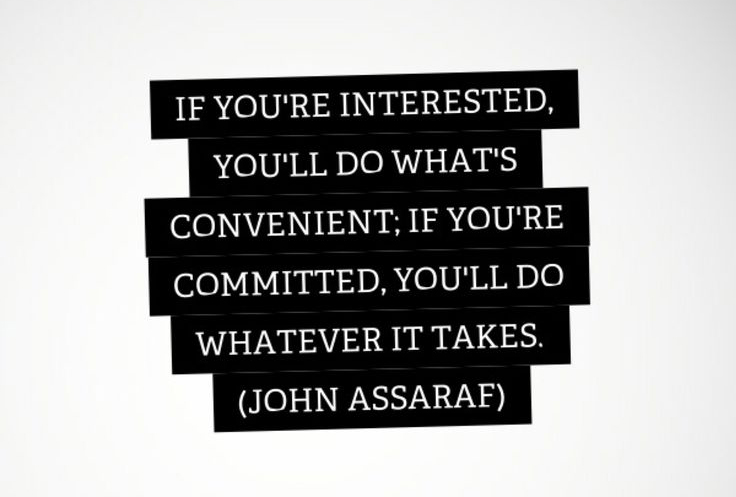
Okay, but why does this matter? I hear you asking.
What can you do?
Here are some steps you can take (and that I'm trying to take) to get around these issues:
Say the important stuff at the beginning of your email. Guys, I struggle with this one so hard, but it's true: put the important stuff at the beginning of your email or it'll never get read.
Send follow-up emails after a meeting. Sure, you took notes, the other people in attendance took notes... but are they all the same? Do they all outline the same goals, objectives and responsibilities? You have no way of knowing, so send a quick summary email detailing the meeting. That way you can clear up any miscommunications and potentially save yourself some hassle down the line.
Break longer emails down into easily readable chunks. If you have to write out a longer email, use bold text to indicate new sections, and try to break things down into lists if possible. If someone opens your email and is greeted with a wall of text they're less likely to spend the time to read the whole thing.
What does this mean for your audience?
If we think about our content strategy with the same focus -namely, that people have limited attention spans and only pay attention to things that interest them- we can start to draw some conclusions which we can apply to the kind of information that we share.
Let's look at a few questions we can ask ourselves:
- What can you tell your audience (besides facts) which will mean something to them?
- Which important details can you focus on to get your point across?
- How can you share content in an original and engaging way to get people interested?
- How can you lead people to the same conclusions or end-goals as you?
By twisting the perspective around and thinking about how you can share more with less, you begin to ask questions which put you in your audience's shoes (spoiler alert: this helps you be better at what you do!)
Awesome! Now what?
Now you can start to apply your new mantra to everything you do! Use the "less is more" mantra to send better emails, have less lengthy and time-consuming meetings and follow-ups, and convey yourself better to your colleagues, clients, and your community.
Got questions? I've got answers! Leave your queries in the comments, tweet at me, or send me an email to continue the conversation!
Power Hour: 60 Minutes to Better Brand Management
Managing your brand's online reputation is one of the most important things you can do to boost your recognition online and help attract, engage with, and build your audience.
Despite this, however, I've met way too many business owners and entrepreneurs who fluff off managing their brand profiles because they don't see it as a valuable way to spend their time. "It's so time consuming!" they say, or "I don't know where to start, so it takes me forever to get anything done."
Like most things, managing your brand can be an efficient process if you know what you're doing, so below are a few ways that you can condense your brand management down into an hour a day
(I know, right?! What will you even do with all that extra time?)

Monitor your social media mentions
(10 - 15 minutes)
In my experience, this is where brands allow themselves to slack off the most; people forget to reply to tweets, dismiss notifications from Facebook, or simply don't know what to say and so they say nothing at all. This is troubling, especially considering that recent research finds that 42% of people on social media expect to receive a reply to a complaint or concern within 60 minutes or less.
This might seem like a daunting timeline, but there are a few ways to keep on top of everything relating to your brand on social media: Twitter, Facebook and Google+ all have built-in search bars, and socialmention.com is a great resource for searching multiple sources for specific keywords. If you're on iOS like me, the Facebook 'Pages' app is a super-convenient (and free!) to manage multiple Facebook pages at once.
If you need something a bit more complex consider options like Sprout Social or Nuvi, which are both really affordable and allow you to monitor multiple terms, engage with your audience, and manage teams if necessary.
Get involved in existing online communities
(10 - 15 minutes)
Aside from social media, other online gathering places where people come together to discuss common interests and experiences are places like Reddit, LinkedIn Groups, and other message boards and popular blogs related to your industry.
By being an active participant on these public spaces, responding to comments, sharing news, and participating in discussions your brand not looks more trustworthy (people figure you have nothing to hide when you're up-front with information) and you build credibility as being a brand who is invested in connecting with their community and developing relationships with your clients.
Protip: if you need to monitor a variety of these communities, consider outsourcing your community management to someone who can dedicate more time to the task. Otherwise 10 - 15 minutes is all you really need.
Monitor and respond to reviews
(10 - 15 minutes)
John and I are currently in the process of planning a big trip next winter, and while looking at places to stay in Guatemala on AirBnB the thing that I found most interesting was the rate of people who came back to leave reviews, both glowing and negative, and how quickly the hosts would hop onto the site and personally thank people for taking the time to leave a kind message, or to apologize and explain why a stay might have been less than perfect.
Common internet sense preaches don't feed the trolls, and while I generally agree with this sentiment, if someone has taken the time to write out a lengthy reply about your business and you have the opportunity to log in and connect with that customer, there's a chance that you might be able to repair that bond.
So if your business is on Google Business, Yelp, or Foursquare, be sure to take the time to monitor the comments and take time to personally reply to them. I was extremely impressed with AirBnB hosts who made a point to connect with and discuss customers' experiences, and ask them how their experience could have been better, and odds are your audience will be, as well.
Remember: there's no way for you to track business that you've missed out on, so doing due diligence and being as connected with every customer and member of your audience as possible is always worth the effort.
Set up blog & media alerts
(10 - 15 minutes)
Setting up alerts is a huge time-saver, and allows you to stay on top of when your brand is being discussed in the media, on a blog, or any of the online forums we talked about earlier. This way, instead of revisiting the same places over and over again, you can set up your alerts and forget about them until they ping you with a notification - then, it's as easy as logging in and replying to whatever your audience has been saying about you.
If you're not looking for anything too crazy, Google Alerts is an easy to use and free alternative, but if you're looking to manage a larger, more complicated brand, Buzzsumo is the way to go. The pro account is $99CAD a month, and allows you to create alerts based on the following:
- Your brand or specific keywords
- Links to a domain, subdomain or exact URL.
- Content from a specific author.
- Content published on a specific domain that reaches a minimum number of total shares.
Wow! Did an hour go by already?
See what I mean? It only takes a little prep and an hour a day to make sure that your brand's reputation is growing, thriving, and (most importantly) conveying the right messages to your audience.
Did I miss anything? Do you have any tips that you'd like to share? Shoot me an email, tweet at me, or let me know in the comments!
Live Your Daydream: How to Make a Living Doing What You Love
Things are starting to ramp up over here at Shaner HQ and lately it seems like I've been getting inundated with people asking me for advice on how to make the leap from boring office job to the exciting (and mildly terrifying) world of running your own business.
While I love talking to everyone individually (I'm a huge chatterbox) it seems like a lot of the same questions keep coming up: how can you figure out what to do? How can you get from 9-5 to full-time business owner? What are the challenges along the way? and so on.
So it seems best to address them in the best way I know how: a blog post, of course!
This isn't going to be a bubblegum session where we talk about the magical dream that is running your own business (though it is pretty kickass); today I want to talk to you about the real-life things that you need to do to start doing what you love for a living.

Figure out what you want to do
So you've got a full-time job that doesn't excite you and you know that you want to run your own business instead, but where the heck do you start? First, figure out the thing that excites you the most and focus as much of your time and energy on learning as much about it as you can.
Maybe you love writing and want to be a copywriter, maybe you love building websites and want to help people build websites for their businesses, or maybe you love knitting awesome sweaters for your cat. Who knows. What matters is that you love doing it, it excites you, and you're dedicated to turning that passion into your livelihood.
The best (and safest) way to start working towards your goal of being a full-time businessperson is to start small. Spend a few hours a week honing your craft, reach out and try to get to know influencers and other people who might be able to help you, find a mentor if possible, and try to gather a small roster of clients.
By having a few clients on the side you can safely get a taste for what your full-time work will be like, start to understand the ins and outs of client relationships, and spend some time thinking long and hard about whether or not these experiences are indicative of the kind of lifestyle that you want to have.
Start to plan
So you've spent some time learning, testing the waters, and have decided to make the plunge into the crazy world of running your own business. Good for you! But before you go quitting your 9-5 all willy-nilly, you need get your ducks in a row first.
Take a step back from your life and look critically at where you are: where are you working? Do you like where you work, and how long are you planning to work there? Do you have any debt, and what are your goals for paying it off? What are your basic costs of living? You get the idea.
Next, sit down and prioritize your goals. For me, my biggest goal was to have as much of my Visa and my student debt paid off before I quit as possible. I made the decision to leave my job in December of 2014, and I spent the next several months working full-time, collecting clients on the side, and using the money that I was making as a freelancer to aggressively pay off my debt. Being able to tackle this huge weight gave me some breathing room when I finally started running my business full-time, and I wish I could go back in time and high-five my past self for being so forward-thinking. I really did myself a solid.

So is there something that you'd like to accomplish, or start doing before you start running your own business? It doesn't have to be debt-related; it could be anything from taking that amazing trip, to buying that new laptop, to meeting with a financial advisor. Whatever it is, do your best to do it before you go solo, because you're going to want to hit the ground running.
Now is also the time to start thinking about the details of your business. By having a deep and thought-out understanding of who you are, what you offer, and the kind of business you want to run before you get going full-time will save you a lot of hassle down the line, and will help you stay laser-focused on your goals.
Some questions to ask yourself are:
- What specific services will I offer?
- What is my ideal number of clients?
- How much will I charge for my services?
- What kinds of contracts do I want to have (eg: recurring, one-time, etc)
- What is the basic monthly income that I need in order to survive?
- How will I find new clients? (eg: blogging, online promotion, Meetups, etc)
- How much money can I save before I quit, and how much runway* will that give me?
*Runway refers to the length of time that your business can exist without collecting any additional sources of income. So, if your client pool dries up, how long until you need to go back to a 9-5.
You get the idea. There are tons of other questions that you'll need to ask yourself that are more specific to your circumstances, but these should get you started.
Treat your goals like recipes
What I mean by this is do everything one step at a time. It can be totally overwhelming to look at all the things that you want to do, or that need to get done, and start to freak out internally because how the hell are you ever going to accomplish all that? By breaking it down, that's how.
Think about your biggest goal and write them down. What do they look like? Do you want to quit your office job by 2016? Be on the cover of your local paper? Land that dream client you've always hoped to work with? Write it all down in as much detail as you can think of.
Now that you've written it down, plot out all the steps that you need to take to achieve that goal and say them out loud as you write them. It sounds cheesy (I know) but it absolutely works. Seeing the words on the page and hearing your own voice saying them helps make those steps seem more real and attainable.
Now that you've set out your goals and broken them down into smaller, attainable steps, it's time to start chipping away at them.
Don't freak out when your plan goes awry
Remember how I said that I had those lofty goals of paying off all my debt before I became a full-time businesswoman? Yeah, that didn't happen. I've made a significant dent, but to quote John Steinbeck: "the best laid plans of mice and men often go awry", and things came to a head at my old job and I had to make an exit before I totally lost my mind. It was a bit sooner than I'd anticipated (by a few months) but by planning ahead and actively working towards this goal for several months beforehand I was in a much better position to start kicking ass and taking names right away.
Remember: just because your plan didn't execute perfectly doesn't mean you fucked up. It means you're human, and it just means that you have one more challenge to face (and overcome!) on your road to independent businessperson fabulousness. Do your best to plan what you can as far in advance as you're able, and when life tosses you a curve ball, you'll be ready to react.
Plan for the best & prepare for the worst.
Be honest with yourself about money
#RealTalk time: running your own business doesn't mean you'll be swimming in giant pools of cash mo-nay immediately. In fact, for most people it takes a long time, sometimes years, to start to really pull in a significant amount of income. Most of us, myself included, take giant pay hits, sacrifice our social lives, travel plans, and long-term goals like home ownership or even having a car because we want our runway to last as long as possible.
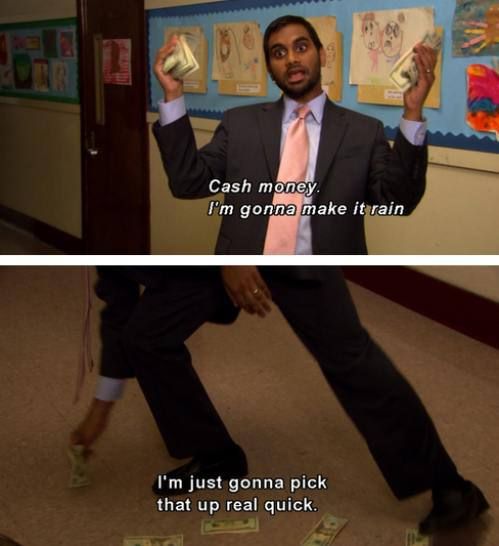
(this is an accurate depiction of what running your own business feels like)
If you've been smart and saving up, or you've got a big cash influx from a contract (or both, if you're lucky) for the love of god don't spend it all at once. I know how good it feels to look at your bank account and see all those dolla bills sitting there, but working for yourself is much more precarious than a 9-5. With a regular job you know you have income coming your way every two weeks (or whatever your pay schedule was) because it was on a schedule, so who cares if you spend a bit extra this weekend - you know exactly when the next influx of cash into your bank account is going to be.
Clients don't usually work that way, and it's not uncommon to wait several weeks for a payment, or for contracts dry up overnight. This is why keeping that runway as topped-up as possible is crucial.
Pound the pavement 24/7
I mean it. When you start running your own business the amount of contact that you need to have with other people (aka "exposure") needs to ramp up significantly. If you weren't active on your own blog, social media feeds, and out and about in your city, it's time to start putting yourself out there.
Believe me when I say this: the amount of work that you put into making sure people know who you are will have significant long-term benefits. It might take some time, but if you can start to develop a positive reputation as being "in the know" about your industry, people will start to defer to you, and eventually will start to refer you to others.
Last year I at one of my speaking engagements I mentioned that I'd been blogging for over a decade, and that experience is what helped me land the role I had at the time. I was speaking to first-year Creative Communications students, and one of them asked "why should I keep my profiles updated when I'm not looking for a new job?" My response to the student was "you never know when an opportunity will find you," and to that I'd like to add that when you run your own business you are always looking for a new job. Ideally you'd like to get yourself to a position where you're turning down work, but until you get there (and if you get there) you need to be as active at promoting yourself and your business as possible.
Ignore the haters
Like the old saying goes: haters gonna hate, and I guarantee you that from the second you mention that you're planning to start your own business there will be someone naysaying the idea right from the get-go. It might be a colleague, friend, family member, whoever. They might put down or dismiss your goals, and will likely do so under the guise of "being concerned" and "caring about your well-being." If anyone in your life says that to you, make a point to respond by saying "if you're concerned about my well-being, then help me achieve this goal because it will make me happy."
Remember: what you're doing takes guts and courage, but it's something that anybody can do if they just work hard enough. There will always be reasons and excuses to not pursue your dreams, and the longer you wait the more you'll begin to sound like everyone else.

Do any of these phrases sound familiar?
"This job is as good as things are going to get."
"I don't have the time"
"I could never make money doing what I love"
"I have too many responsibilities and it's too late now"
I grew up hearing all sorts of BS like that, too. My dad has worked in the same department since his early twenties, my mom never went to college, and growing up I was surrounded by people who simply settled for their lot in life and never tried to push themselves (though man did they ever bemoan their circumstances.) These influences led me to believe that running a business was this unattainable and foolish goal, and something not worth pursuing.

If there's anyone in your life echoing similar sentiments, tell them where to shove it. Life is too short to spend waiting around for the perfect time (which will never come) or trying to please everyone (which will never happen.) Here's a great quote on the matter:
“In every industry, there is an edge. In your business or personal life, it doesn’t matter– somewhere, there is a cliff. Most people don’t want to get to close to it, because they’re afraid they’ll fall off.
Thing is, the edge is where all the cool stuff happens. I know you don’t want to make a decision that is irrevocable and wrong– a decision from which you might never recover– that’s natural.
But guess what?
You are actually in the middle of an open field, inside your house, clutching your purse, crying like a little girl while looking at an edge you see on television.
In other words? You are nowhere near the goddamn edge.
It’s time you stopped being a fucking pussy.”
Julien Smith
Still feeling stuck? Get some help
If the idea of starting your own business is still way too daunting (and that's totally okay!) here are some great resources, articles, and people I'd recommend working with to help set you on the right track:
How to Do What You Love
An amazing article by YCombinator founder and overall genius Paul Graham
Kyla Roma
Business coach & strategist, and totally badass babe (also someone I know personally & adore)
Futurepreneur Canada
Tons of resources for mentors, coaches, funding options, etc (for Canadians)
Miracle Worker
8 week online course by Gala Darling & Ellen Fondiler
Seth Godin's Startup School
A free podcast series by Seth Godin, world-renowned marketing author, thinker and overall clever dude
Moz Learn
Learn everything there is to know about inbound marketing with this series (which I highly recommend)
Still have more questions about running your own business? Want me to expand on any of these topics? Shoot me an email, tweet at me, or let me know in the comments!
Crowdfunding Crash Course: Alex Tinsley - Knit It Black
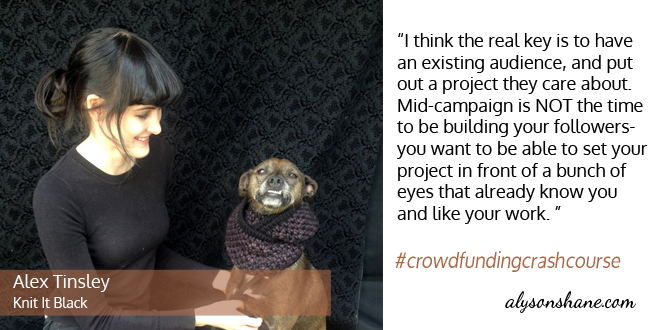
Alex Tinsley has been designing knitting patterns under the label Dull Roar for eight years, and used Kickstarter to fund her project Knit It Black, a collection of all-black knitting patterns.
Can you briefly describe Knit it Black?
Knit It Black is a collection of all-black knitting patterns, designed to raise awareness and funds to benefit animal rescue- specifically, black-coated animals, which have a tougher time finding homes in shelters.
Why did you feel that the crowdfunding model was the best way to promote the project?
Well, my only other choice was to try and fund the whole project out-of-pocket, which may have been do-able, but it wouldn’t have been nearly as good as it can be now. There aren’t a lot of other options for getting funding in this field. Crowdfunding allows people to get involved at the ground floor, support something they believe in, and pre-order the product, in a way.
Why and how did you choose Kickstarter over other crowdfunding options available?
I’ve used Kickstarter before and had a good experience, so I figured, why not? Indiegogo seems like a good option too but I’ve never tried it. Initially I chose Kickstarter because they are the most well-known and widely recognized platform, but when you’re bringing your own audience I’m not sure that choosing one platform over another matters too much.
How big was your budget before you launched your crowdfunding campaign?
Almost nothing, honestly. I made the video with the video functions on my iPhone and Canon DSLR, edited on software that came with my computer; a friend donated the music, and I reached out to my Twitter and Facebook communities for photographs of black pets to use. It’s not a great video, but it gets the point across. If I had been funding the project out of pocket it would have taken a very long time, as I put it together piecemeal between my other work, investing a little bit here and there as I could afford to.

How far along was your project before you felt ready to launch a crowdfunding campaign? In hindsight, would you have preferred to be farther along, or to have crowdfunded earlier?
I had several of the items knit or partially knit, and most of the project planned out in my head, but in July I was offered a good advertising opportunity starting in August and I knew I wanted it to be for the Kickstarter...which meant I needed to get it rolling NOW. Then my photographer had an opportunity to come to town later in August, which means I have to get the knitting done ASAP as well. I feel good about this timeline, though- I work well on a deadline.
Can you explain how you prepared for and managed your campaign?
First I made a big list of all the expenses, to figure out what my goal number needed to be. Then I started brainstorming prizes, and factoring in those costs as well. I reached out to a few people to help me out - the musician, a yarn dyer I had previously mentioned the project to, etc. I was very lucky that everyone was able to work with me on a very quick timeline.
Actually shooting and editing the video was the most gruelling part- I don’t particularly like hearing myself on camera, and dogs never seem to do what you want them to do when you go to record, haha. “Managing” hasn’t been bad- mostly just answering questions as they come up and responding to the feedback I’ve gotten. The real work comes when it ends and rewards need to be fulfilled.
What tools did you use to market your campaign? Do you feel like you did so successfully, and if not, what could you have done differently?
I went through the same channels that I usually use to promote my knit design work - Twitter, Facebook, my blog, my newsletter, Ravelry. It got funded and then some, quite quickly, so I’d say it was successful.
In retrospect what were your best assets for running this successful campaign? On the other hand, what would you do differently?
I think the real key is to have an existing audience, and put out a project they care about. Mid-campaign is NOT the time to be building your followers- you want to be able to set your project in front of a bunch of eyes that already know you and like your work. I don’t think it hurts to appeal to multiple interests - in my case, knitters, animal rescue supporters, and people who like dark fashion. My audience is mostly knitters but I know there’s a lot of overlap.
What was your biggest challenge during your campaign?
Getting it done in a hurry! It’s easy to put off a big project like this, especially when it involves some stuff you don’t really like doing (video, for me) but having a firm deadline really got my butt in gear.
What’s the most valuable advice you could share with aspiring crowdfunders?
Build an audience first- and build the *right* audience! If I have 2000 knitters following me on Twitter and I try to launch a Kickstarter to, say, start a bike company… I’m going to get a lot less response than if I’d matched my project to my audience. Honestly I think that’s far more important than a flashy video or tempting prizes- deliver a project people care about, to the people who care about it.
This post is part of a series! For more interviews and summary posts, check out the Crowdfunding Crash Course page.
Marketing Your Brand Through Storytelling

Stories are way more memorable than regular 'ol marketing content, and are a great way to tell your audience about your brand, build trust, and help them see you as more than just a company or an organization.
There are a couple of ways that your brand story is built: either through content created by you (blog posts, social profiles, etc) or by stories and experiences that your audience share online.
The culmination of both of these tells your brand story, and by being pro-active and sharing content about you, your team, and your brand, you can help shape the way that your audience interact with you, and influence how they help you tell your brand story.

Tell your origin story
Like any good superhero, your brand needs an origin story. Nostalgia is the best way to connect history to your brand, product, logo, etc and it helps re-affirm your brand's vision and goals to your audience.
It doesn't have to be wild and crazy (unless you actually were bitten by a radioactive spider) but it does have to meet the following criteria:
- Be true (don't lie, guys. The internet will find out and you'll lose all your cred)
- Be interesting (really this is just in how you tell it; rhetoric is key)
- Be honest (tell your audience what motivated you, what your struggles were, etc)
This is important because people want to know the history behind a brand or product before they begin to attach themselves to it emotionally. The more compelling your reasons for founding your cool startup or starting to knit all those awesome cat sweaters, the more people will give you emotional buy-in (that is, start to genuinely care about you) and the more attention you'll get.
Talk about your goals & challenges
Once you've started to share where you came from, talk about where you're going and chronicle the steps you're taking to get there. Share blog posts, photos and video of the project as it develops. Blog regularly about your progress, the things you've learned, technical problems you've been struggling to solve (and how you solved them) - anything that shows your audience that there's a real person (or team of people) behind the scenes.
If you're a multi-person organization, having various team members from different parts of your company share content is a great way to connect with a variety of audience members. For instance, have a programmer blog about challenges they had building a section of your product, or have your graphic designer share an Instagram photo of a few concept pieces (bonus points if they can briefly discuss why they were or weren't rejected.) By sharing a variety of stories describing your goals and challenges, your brand appears more dynamic, interesting, and relatable.
Talk about your audience
One of the best ways to connect with your audience is to tell a story about one of your consumers, or a member of your community. This is a neat trick to include people in your brand's larger story, and encourages others to contact you with their own experiences in the hopes that they can be included, too.
A great example of this is Apple's iPhone commercials, which show regular people taking photos and video using their iPhone camera. This is a great example of brand storytelling, and it doesn't even use words! The reason this is a powerful technique is because showcasing other people's experiences helps put your audience in a similar mindset. They start thinking "what is my experience like? Do I relate to what I've seen? Why or why not?" (maybe not quite that linear, but you get my drift.)
But what do you do if you don't have a product on the market to replicate an Apple-esque story? Instead, find testimonials from people who have tried your software, worked with you in some capacity, or done some beta-testing and would be comfortable sharing their experiences. Don't limit yourself to consumers; anyone can be a part of your brand's story if you invite them in.
Still stuck?
Here's a handy print-out for you to fill out and use (or just to get you thinking!) about the kinds of stories you can tell about your brand.
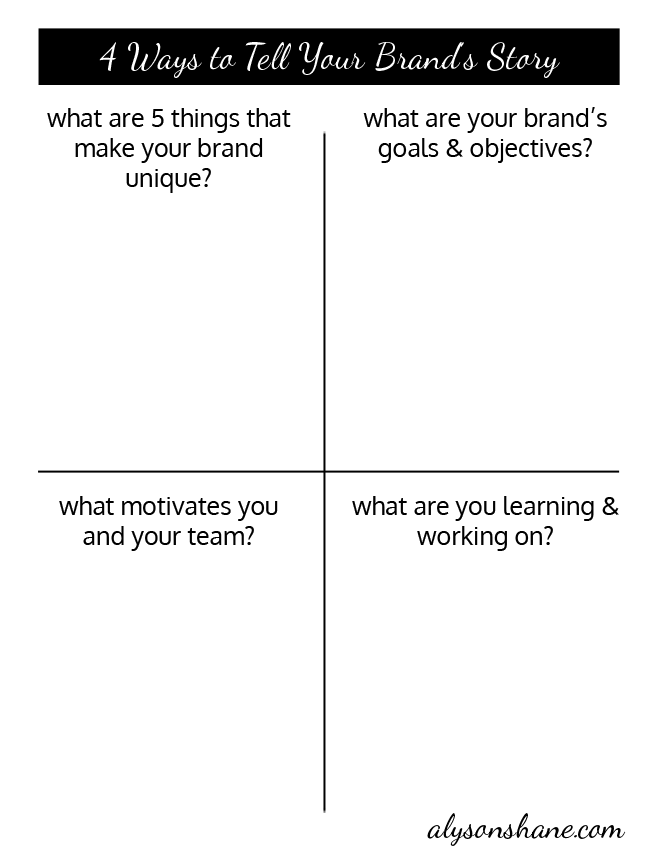
Do you have any favourite brand stories? Have you ever been featured in one? I'd love to know!
In My Community: the CEO Sleepout + why it matters to me

Yesterday I attended the press release for the 5th annual CEO Sleepout, organized by the Downtown Winnipeg BIZ.
The CEO Sleepout, which is in it's fifth year, aims to create employment opportunities for Winnipeg's homeless community, and to create dialogues among over 150 CEOs, community leaders, and media about our role in addressing and eliminating homelessness in our city. In the past four years the Sleepout has raised over $600,000 from the private sector, which has helped employ nearly 137 people experiencing homelessness for more than 51,000 hours of employment - with many of them returning to school or finding permanent full-time work.
On September 24th members of Winnipeg's business community (myself included) will spend a night on the streets at Portage & Main, discussing issues and possible solutions to end homelessness, touring downtown with individuals who have experienced homelessness to hear about their personal stories, and spending a night outside to experience a small taste of what it's like to be homeless in Winnipeg.
I'm really excited to be participating, and helping to raise money and awareness for this amazing cause.
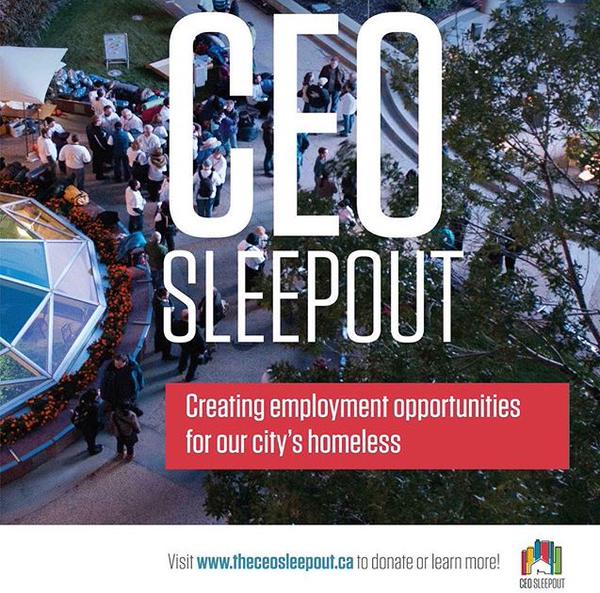
I grew up being quite sheltered. My parents moved me to a suburb called Riverbend when I was a kid, and with downtown a solid 45-minute bus ride away, I didn't spend a lot of time in our downtown core as a young person. I'm pretty embarrassed to admit this, but the first time I spent any time in the Exchange District was at 18, and I spent the entire time gripped with fear that a homeless person would accost me and take all my stuff.
Part of the problem of growing up in a suburb is that you develop a very "us vs them" mentality about your own neighbourhood versus the downtown of your city. In Winnipeg, at least, many of our young people (myself included) grow up holding extremely prejudiced and narrow-minded views about homelessness, Aboriginal issues, and individuals experiencing poverty. We don't see the issues that plague people experiencing poverty and homelessness as something that we need to address because we can simply hop in our cars and drive back to our sprawling suburbs, ignoring the problem completely.
I'm fortunate that I grew out of this phase in my thinking. When I moved out of Riverbend I lived in Osborne Village for a year, and then to West Broadway in order to be closer to school (I attended the University of Winnipeg, where the entire campus is located downtown.) West Broadway is one of the poorest neighbourhoods in the country, and living in a mixed-use and mixed-income neighbourhood, and attending a school like the University of Winnipeg which encouraged discussion about the specific challenges that Winnipeg faces in terms of public discourse and action to combat homelessness, was an eye-opening experience.
I started to see Winnipeg, and the people in it, as my responsibility. Living downtown and getting involved gave me a sense of community that I'd never felt while living in Riverbend; suddenly I wanted to see my city thrive and succeed because it meant that everyone -not just me- would get to benefit from it's success. A rising tide lifts all boats, as the old saying goes.
I was lucky: I experienced a specific set of circumstances which allowed me to develop beyond the close-minded views I had been raised with. However, many people in Winnipeg (and elsewhere) still consider homelessness and other socio-economic issues to be something that simply "isn't their problem."
That's why I decided to get involved with the CEO Sleepout. I want to raise awareness about an issue that concerns all of us, whether we live in Riverbend, Wolseley, St. Boniface or Transcona. Everyone in Winnipeg has a responsibility to do our best to make our city a better place to live - for ourselves, our kids, and for everyone else who calls Winnipeg 'home.'
I'll be collecting donations until the day of the event, so please give generously and consider donating your time to help out at local shelters and resource centres like Siloam Mission and RaY: Resource Assistance for Youth.
Ending homelessness won't be an easy task, but by working together and raising awareness we can start to make real change in our city. Let's do it together.
The Guide to Creating Killer Content

Once upon a time, back in the old days of 1996 Bill Gates wrote an article called Content is King. In it, he talks about the future of the internet, and how this new and exciting medium can be used to distribute information worldwide at basically zero cost. He also discussed how content isn't one single idea or thought, but rather the sum-total of everything that we share online, which can include ideas, products, and experiences.
Bill Gates is clearly a clever guy (duh) and his article is still as relevant today as it was when I first read it in Computer Science class. Nowadays, however, we have a multitude of ways and means to create and share content under the guise of your brand, professional or personal.
This can be anything including:
- Your website
- Blog posts
- Original images, photos and infographics
- Your profile photos across social networks
- Social media profiles including:
- Tweets on Twitter
- Facebook status updates
- Instagram photos
- Youtube or Vimeo videos
- Pinterest pins
- Google+ content
- LinkedIn updates
- Newsletter emails
- Emails you send to clients and colleagues
- Handouts, checklists, ebooks and resources you've created
- Other stuff of this nature (you get the drift)
The sum total of all of this stuff is how people will perceive you online, so your content really matters. People will click around to your Twitter, LinkedIn, Pinterest, website, and anywhere else you hang out online to try and suss out who you are and what they think of you.
The kind of content you share determines your value to other people, so today we're going to go through a few quick & dirty questions that you can ask yourself to make sure that you're creating and sharing the best possible content that helps people see who you really are, and adds value to your brand.
Does your content help others?
One of the biggest takeaways for me from the #SocialHour Twitter chat last week was that everyone indicated that they considered quality content to be helpful and informative. People are looking for posts, articles, and images that give them information and help them solve problems that can't be easily Googled.
This means that some of the best content you can create is the kind that answers questions, presents solutions to problems, and is otherwise generally helpful.
Here are some questions you can ask to determine some helpful content you can create:
- What kind of content do you like to read?
- What kind of content does your audience like?
- Hint: check stuff like your Twitter analytics to see what sorts of shared content resonate with your audience
- What sort of content are other businesses in your field sharing?
- What kinds of questions are being asked in blog comments, Twitter chats, etc that you can answer for my audience?
- What sorts of topics interest you, and would be fun to explore and learn in order to share?
- Can you turn any of these content ideas into long-term projects, video tutorials, printables, white papers, and other resources your audience can use?

Are you authentic?
Aka, does the way that you're presenting content online jive with who you are in real-life?
We all try to put forward the best versions of ourselves online - that's normal, don't worry about that pressure (we all feel it) - but when it comes to our content we can share heaps of information, articles, and posts without actually saying anything about who we are if we're afraid to do so.
However, the more 'real' we can be online, the more people will gravitate to us and hear what we want to say. This is because people (read: your audience and potential future clients) aren't just coming to you because you have encyclopedic knowledge of Google Analytics, or you knit the best cat sweaters. They're coming to you because the like who you are, and part of helping people get to know the real you is by sharing parts of your life with them.
Here are a few ways you can help people get to know you:
- Share funny or interesting photos of your life
- Include relevant stories in blog posts and status updates
- If you're feeling brave, share a recent struggle and what you've learned from it
- Share what you know (check out The Case for Knowledge Sharing for more on that topic)
Additionally - and I've said this before - make an honest and concerted effort to be positive online. Part of being authentic is sharing your struggles, challenges, and learning experiences, but don't actively badmouth, vaguebook, subtweet, or write passive-aggressive posts or emails about other businesses or people. We all have catty moments (we're human, after all) but you never know when it will come back to bite you.
Is your content entertaining?
#RealTalk time: you could be providing the best, most helpful content on the planet but if your posts read like cardboard and you sound like a Speak 'n Spell on video, nobody's going to want to take the time to hear what you have to say.
Here's an example: When I was in high school I had an amazing teacher named Mr. Kenny. He was so freakin' weird, you guys. He only cut his hair once a year for his wedding anniversary, wore a red nylon strap as a belt (the kind backpacks come with), and had less than a dozen tshirts, all of which he got for free and one of which said Is that your final antler? on it. He had the weirdest stories (like punching a kangaroo) and was always incredibly entertaining.
Mr. Kenny taught science (which I was embarrassingly bad at) and his students generally did really well because he was into what he was always super excited about what he was teaching, and he was such a character that he didn't have to work very hard to keep our attention.
Nowadays when I'm writing, or sharing things online, I try to channel Mr. Kenny's weirdness because I know that keeping people entertained is what keeps them coming back. It's not just about sharing information, it's about doing so in a way that keeps people interested and entertained.
How can you be more like Mr. Kenny? Ask your self some of these questions:
- What sorts of personal stories can you use to make your content more relatable?
- Can you work sarcasm and jokes into what you're writing?
- Can you find relevant interesting or funny photos, gifs, and videos to complement up your content?
- Would your audience appreciate seeing your goofy side?
Your turn!
Here are a few questions to get your brain waters going:
- What kind of content can you create this week that will benefit your brand?
- What fun, personal thing happened to you today that I can share with your audience?
- What are five topics I can write about this month that will benefit my audience?
Stumped for ideas? Leave a comment and let's chat about it!
#SocialHour Twitter Chat Post-Mortem
This past Tuesday (August 11th) I hosted my very first Twitter chat. Called #SocialHour, the chat is dedicated to helping people discover how to grow and engage with their communities, and I'm pleased to say that it was a resounding success!
We had over a dozen participants (not too shabby for a brand-new chat) and our hashtag was trending in Canada! YAHOO! This give me warm fuzzies like you wouldn't believe.
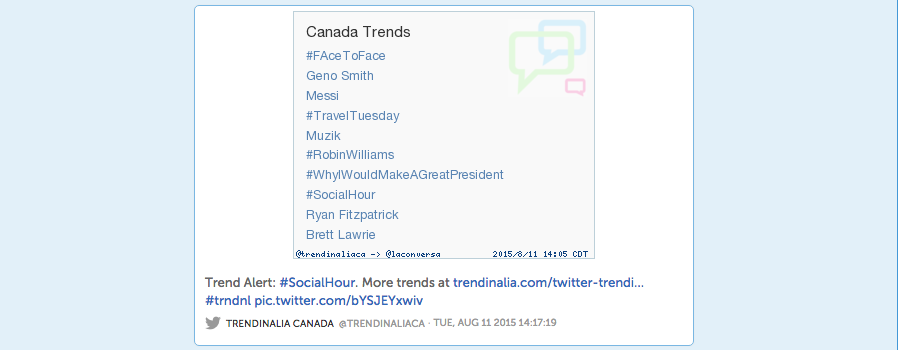
My elation aside, hosting my first chat was a huge learning experience, to say the very least. I did a ton of research up-front and I still felt like I was scrambling to keep up with stuff sometimes.
Real talk though, hosting a Twitter chat is a ton of fun, but it's a lot of work. I had to do a ton of up-front research and a lot of on-the-go learning during the actual chat itself.
With that in mind, I wanted to do a bit of a 'post-mortem' with you to go through how I prepped for my chat, the tools I used (which ones I loved and which ones I won't be using again), and how I'm setting myself up to make sure that next time is an even better time!

Prep, prep, prep
I can't under-emphasize this enough: running a successful chat requires a ton of preparation. Even before you announce the chat itself, there's a ton of up-front work that goes into preparing for a chat to make sure that it's adequately promoted and planned.
Here are the steps I took:
- Figured out my time/date for my chat in advance
- Wrote a blog post explaining what #SocialHour is, how to participate in a Twitter chat, etc
- Created a custom image to announce my chat
- Tweeted about the chat frequently and pinned a Tweet about it on my Twitter profile
- Prepped LOTS of questions and selected several that I wanted to use from the pile
- Pre-wrote my answers (since I have to participate, too)
- Included the #SocialHour hashtag in the prepped Q&A's and did a word count to make sure they fit within 140 characters before I scheduled them
- Scheduled my questions and answers before the chat started so I could focus on engaging participants and moving the conversation along
- Did some research into chat moderation options (more on this below)
Reach out
One of the things that I'm getting over as a business owner is that it's my responsibility to promote myself and my activities, and that it's not "being pushy" or "being salesy" to invite someone to participate in something, or to ask for feedback.
That's precisely what I did: I made a point to reach out to a few people that I know who I thought would enjoy the chat and would be active participants, and followed up with people who had expressed interest in joining. It was as simple as sending a DM with "hey! I'm hosting my first chat called X at X time, I'd really love it if you joined us!"
I also asked participants to provide me with feedback after the fact, and have received a few messages with suggestions and thoughts, which have really helped me hone my ideas for the next chat.
Know which tools to use
Since this was my first chat I was experimenting with a few options to moderate my chat: Twubs, Hootsuite, and regular desktop Twitter. Here's a brief review of how they all worked for me:
Twubs
This tool was pretty much useless. I'd read a ton about it, and it seemed like a viable option, but unless you buy into their 'Basic' plan which is $99/mth it's really not that helpful. All it did was show me a tweet wall and auto-include the hashtag in my replies, which (while helpful) didn't really save me that much time. I also find their website extremely cluttered and annoying to navigate, so I'm unlikely to be using this tool again.
Hootsuite
Hootsuite was pretty helpful fro managing my chat because I could easily create 'streams' for the chat, which meant I had a dedicated #SocialHour stream. It was really helpful to be able to see everything at once: my replies, what I had scheduled to go out, and the activity on the #SocialHour stream.
I definitely made the right choice scheduling my questions and answers in advance, but ran into an issue where my answers sometimes posted before my questions, even though they hadn't been scheduled in that order - Hootsuite only allows you to schedule content in 5-minute intervals, so I figured if I scheduled two tweets to go out at 1pm in a specific order, then they'd post that way. Apparently not. So I had to manually take out the Answers and then paste them in after I saw the auto-posted Question. This added some seriously unnecessary hassle that complicated things a bit.
Twitter Desktop
I actually used straight-up Twitter more than I did any other tool. I realized pretty quickly that Twubs was out unless I paid for it (sorry, $99/mth for a single monthly chat is more than I'm willing to pay), and Hootsuite got a bit overwhelming at times and didn't refresh super-quick (this might be an issue with Twitter, though, and not their fault.)
I found that the easiest way to stay on top of everything was to park myself on the #SocialHour feed and hang out on the 'Live' stream - this way I saw everything that was being said in real-time and had a pretty good handle on who was saying what, and to whom. I don't think this tactic will scale up very well, though, as the chat begins to grow, so I'll definitely have to look for a suitable alternative.
Recap it afterward
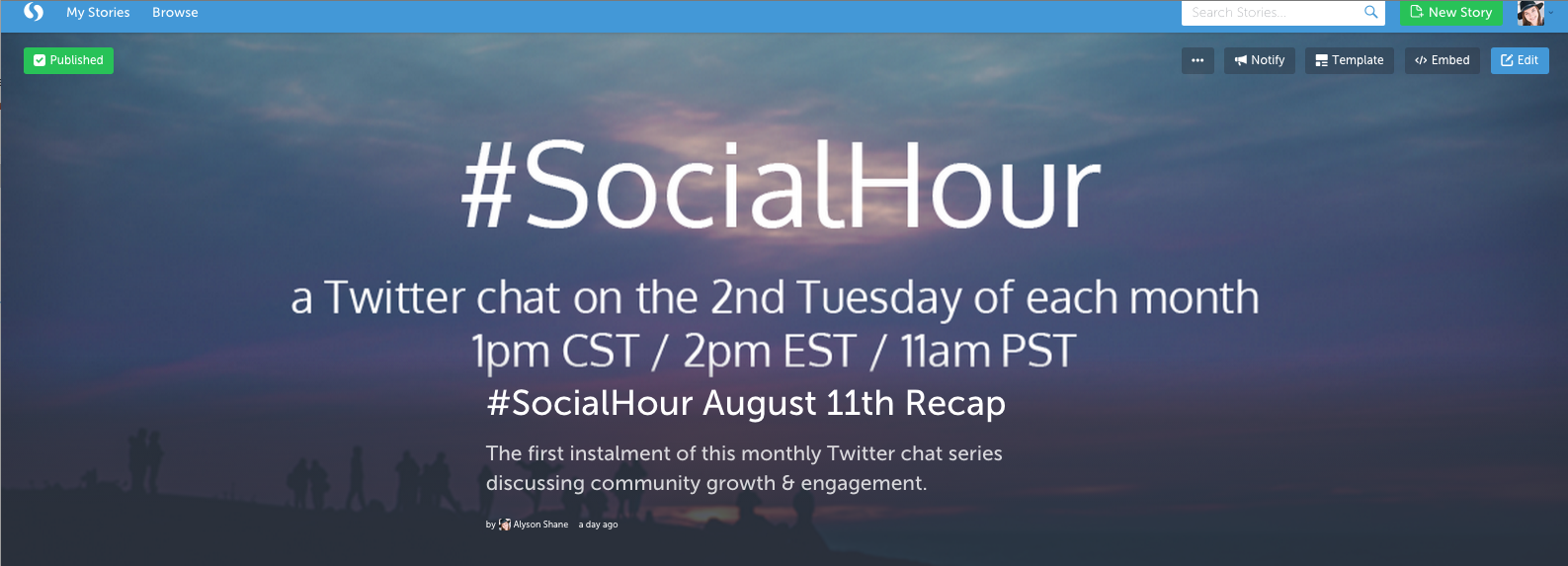
Odds are you'll want to reference your chat for later, and the best tool I've found for this purpose is Storify: if allows me to create a timeline of the chat and save it for others to see. It's also a super-easy format to read, and logs things chronologically, which saves a ton of time.
If you missed the #SocialHour chat, you can find a recap here.
This isn't just an important step for your audience, however; it's also super-helpful to be able to go back over a chat and see trends and themes that emerged, your most active participants, etc. Being able to sit back after all the madness has ended (ideally with a cup of something delicious) and take the time to peruse how things went is invaluable. Here's some stuff to look for:
- How many participants did your chat have?
- Which questions resulted in the most responses?
- Did other topics come up that might be worth discussing in a future chat?
- Which participants in your chat were the most active?
By tracking your chats over time you can start to develop an in-depth insight into the kinds of topics, questions, and conversations will result in higher levels of engagement, which helps your chat grow and succeed!
Do you have any tips for hosting a Twitter chat, or any favourites that you like to join?
I'd love to know!
